When Wilbur and Orville set out to fly their first airplane 120 years ago, aeronautical knowledge was rare and precious. Pioneers like Lilienthal preceded the Wright Brothers but the Ohio bike shop owners still had to figure out almost everything. They did so without funding, university degrees, or government help. Today, nearly every aviator celebrates their December 1903 achievement.
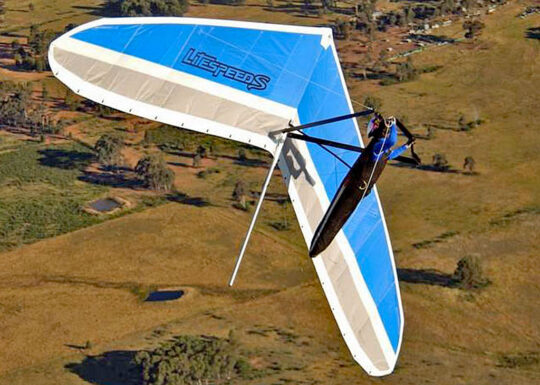
image: Delta Club 82 (France)
Aviation is a many-varied activity, though, and not all aircraft followed the same development path. Especially after World War II and the arrival of kit-built aircraft, American aviators began exploring in many directions.
Around the time NASA was pushing hard to land on the moon, a growing group of enthusiasts were jumping off mountains in pursuit of flight. Hang gliding soared into sky in the late 1960s and early 1970s. Enthusiasts grew to more than 100,000 active hang glider pilots globally, flying in nearly every country on Earth, perhaps as the most affordable of all aircraft.
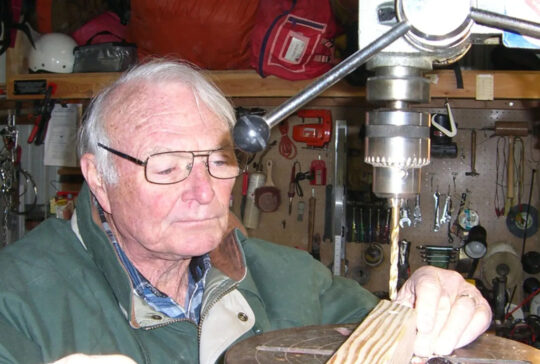
See coverage of John Dickenson‘s achievement in this video.
Modern hang gliders have become quite sophisticated. They can be flown for hours, soaring thousands of feet into the air. Some pilots have achieved flights covering hundreds of miles.
They would not likely have succeeded were it not for the innovation of John Dickenson, a name you probably don’t know. His work is sufficiently obscure that even most hang glider pilots don’t know his name. John passed away this year.
Light Aircraft Pioneer
Longtime hang gliding industry veteran Malcolm Jones* sees a direct line from John Dickenson’s work with the triangular control bar to motorized hang gliders, to Part 103 ultralights, to LSA, and right into the present. While it’s true the triangular control bar is only used on weight-shift aircraft, those early flying machines that were affordable to experimenters like Dickenson were pivotal developments to the entire light aircraft community.
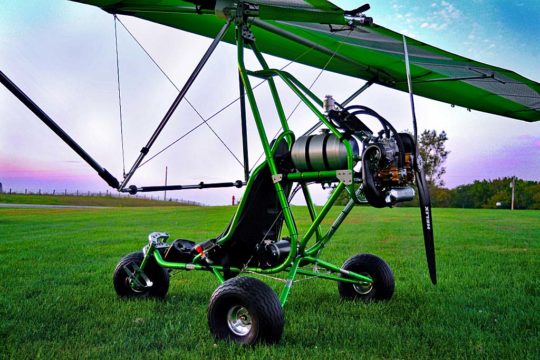
Weight shift trikes like this Rev from Evolution still use John’s triangular control bar and still suspend the weight of carriage and pilot from the center of gravity.
Is flying a “sport?” GA pilots and LSA pilots rarely use that term, but skydivers, hang glider pilots, paraglider, and powered parachute pilots often refer to their activity as a “sport.” Is that a difference without a distinction? Maybe, unless you are one of those enthusiasts. I am, and I get their meaning. Among this crowd, Dickenson should be regarded as a hero yet most missed his contribution …maybe because it was too simple.
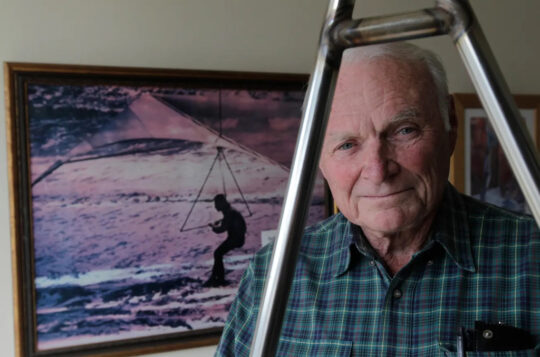
In this well-composed image taken for a Sydney Herald article, you see John’s triangular control bar and suspended pilot in the background image with a welded steel control bar used for boat towing in the foreground.
Malcolm expressed, “For a long time I’ve felt our modern hang gliders should’ve been called Dickenson Gliders (that use a Rogallo-type wing).” He refers to Francis Rogallo, a celebrated engineer contributing to NASA’s need for reentry vehicles (hence the delta-wing-shaped gliding parachute that lead to hang glider wings). Today, most hang glider pilots call their aircraft a “Rogallo wing.”
Dickenson’s control system is still used in modern gliders.
Malcom explained, “A few guys were ground skimming down hills with Rogallo-type wings, hanging from their arm pits on parallel tubes. They didn’t get this sport going. They had not figured out sufficient control, swinging legs left and right for lateral control while having almost no pitch control. The parallel-bar method was very marginal at best.”
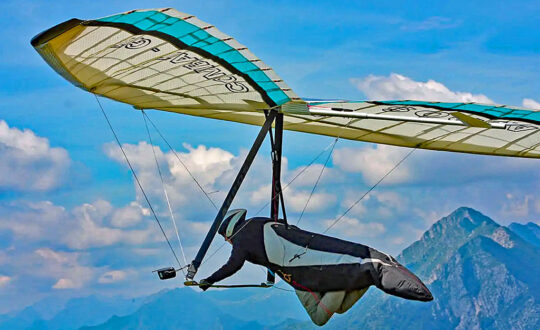
Modern hang gliders are sophisticated aircraft you can carry on your shoulder. Here a pilot launches and enters his cocoon harness for the least drag and most comfort. He is suspended from aircraft C of G and uses the triangular control bar to move his weight relative to the wing. It takes only a light touch akin to moving the handle bar on a bicycle.
“Dickenson was the idea man behind the triangle control bar and flexible suspension,” Malcom clarified. “As simple as this idea was, suspending the pilot’s weight from CG — the reason it’s called ‘hang’ gliding — plus the triangle control bar, are really the innovations that changed everything and sparked the proliferation of hang gliding. Lots of people from Leonardo da Vinci, Lilienthal, the Wright brothers and more designed gliders, as we know, but none of them were the design that spawned our sport.
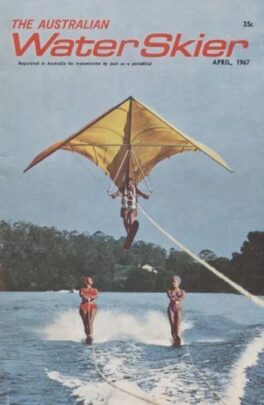
“I just see John Dickenson’s triangle control bar and pilot suspension as a meaningful catalyst that provided a way… a thread to how hang gliding and its leaders — Thevenot, Peghiny, and others — branched into weight-shift trikes and other ultralights and ultralights in-turn to Light-Sport to our current segment of sport flying,” Malcolm concluded.
Full article about John Wallace Dickenson (1934-2023) appears below the video
* Malcolm Jones founded and operates the Wallaby Ranch a few miles south of Disney’s complex in Orlando, Florida. The most-developed hang glider towing operation of its kind, Malcolm and his “Ranch Hands” have flown several tens of thousands of students without a single incident over more than three decades. Malcolm has flown numerous celebrities, most recently Mike Rowe of TV’s “Dirty Jobs” fame (video below). ••• The hang gliding portion starts at 11 minutes into the video.
Mike Rowe fans and many others will enjoy the TV star’s description of flying a hang glider… an unscripted experience:
SEE a video about John Dickinson by clicking this link.
Tribute to John Wallace Dickenson (1934-2023) appearing in the Sydney (Australia) Morning Herald — August 2023:
In 1963, John Dickenson invented and built the first modern hang-glider. It flew with the help of friends Rod Fuller, the test pilot, and Pat Crowe, who towed the aircraft behind a boat at Grafton.
John Wallace Dickenson, who died on July 5 following a short illness, is regarded as the father of the modern-day sporting hang-glider.
The sport of hang-gliding really took off in Australia after Dickenson developed a glider that was robust, able to withstand repeated crashes and still fly, and was easy to transport and store.
His design could be understood after a moment’s viewing or looking at a picture, replicated for $30 at the time, with no special tools, materials or knowledge, and often flown the same day.
The glider was easy to fly thanks to Dickenson’s pendulum weight-shift control system, which was intuitive and efficient and provided abundant control – the pilot could achieve Icarus’ dream by simply running off a hill and learning on the way down.
The magic of his device is the conjunction of extreme simplicity, user-friendliness and ability to copy. No other aircraft has been as easy to build, fly and duplicate as the Dickenson wing.
The glider was easy to fly thanks to Dickenson’s pendulum weight-shift control system, which was intuitive and efficient and provided abundant control – the pilot could achieve Icarus’ dream by simply running off a hill and learning on the way down.
The magic of his device is the conjunction of extreme simplicity, user-friendliness and ability to copy. No other aircraft has been as easy to build, fly and duplicate as the Dickenson wing.
The flights that Moyes and Bennett flew proved the obviously superior nature of the Dickenson glider. And when they encountered individuals or groups, their spirit of generosity meant they were happy to share their knowledge.
Around the world, the number of Dickenson hang-gliders went from a few dozen in 1969 to tens of thousands in just six years, when hang-gliding became part of the Federation Aeronautique Internationale, World Air Sports Federation.
Dickenson was born in Sydney on January 22, 1934, and studied for a radio and electronics certificate at Sydney Technical College. On qualifying as an electronics technician he completed a further year studying monochrome television design and servicing.
Completing his national service with the RAAF at Point Cook in 1955, he became a radar and electronics technician, undertaking further studies in electronics and, in the 1970s, gaining a diploma in management. In the 1980s he completed a BA in psychology at Macquarie University, with postgraduate studies in psychotherapy.
He was a keen motorcyclist, tennis player and surfer, and he spent a lot of time sailing, in some boats using hydrofoils of his own design.
In 1955 he married Amy Prinold at Manly and they had two children, Mark and Helen. In 1960 they moved to Grafton on the Clarence River, where he was employed at Gus Robinson Electrical as an electrical technician, repairing and overseeing the installation of radios and televisions.
The family returned to Sydney in 1966. He worked as a specialist sales engineer for numerous companies, including Phillips and Siemens.
In 1970, while working on a motor system for his glider, John and Amy witnessed a gyrocopter crash. Amy was alarmed and worried about the possible outcomes of John’s plans, and the possibility that she could end up widowed with two children to raise.
After a discussion, and as he could no longer see any possibility of earning a return from the glider project, Dickenson abandoned it – from time to time quietly dropping in to see Moyes at his workshop, to help with further development ideas.
Dickenson’s control system is still used in modern gliders.
The modern hang-glider is the invention that history will remember. However, his interest in fluid dynamics led him to work on flow-measuring systems, registering designs for flumes and for slot systems that were used in many places, including the St Marys Water Treatment Works.
He received the Order of Australia in 1996 in recognition of his services to flying, through the invention of the “Delta Ski Wing” and the development of hang-gliding, paragliding and the microlite airplane.
He was awarded the FAI Gold Air Medal in 2011 and the Royal Federation Aero Clubs of Australia Oswald Watts Gold Medal Award in 2012. In 2017 he was made a Member of the Order of Australia.
Amy died in 2002 and in 2009 Dickenson married Patricia “Tricia” Rohrs, who also predeceased him.
John Dickenson is survived by his brother Eric, his sister Wendy Gerdes, his son Mark and daughter Helen.
by Graeme Henderson



I write this as a World and National record gain of height of 13,200ft in an Aolus 170 Hangglider in 1981. As to assume that hangglider pilots are too stupid to know of or read about Rogallo and his design comparisons to the modern day Hanggliders is an insult to all who fly and more knowledgeable than YOU as to the sport and it’s history. Shame on you
I don’t “assume” that hang glider pilots are too stupid to comprehend Rogallo’s corruption and total lack of any contribution to any form of aviation, but the proof is hard to miss, have you some proof that tI am wrong?
Gertrude and Francis Rogallo were frauds, thieves, and liars. They sucked all of the morons in.
And not just Hang Glider pilots, look at Fliars Appendix G and see how dumb the curators at the Smithsonian Air and Space Museum are.
Of course, if you have some hard data that shows an actual contribution by the Rogallos I will happily change my position.
Congratulations on your records, But they have no bearing on this discussion at all.
Read Fliars, Examine all of the evidence provided, and then get back to us. What you believe is worthless, show us what you can prove!
Fliars and all of its appendices are to be found here: https://www.dropbox.com/scl/fo/b0wguejf2uxm2mbw4j5iw/h?rlkey=tskxcgvwsl6dpuh40duzv49ph&dl=0
The Bandwagon Fallacy
The Appeal to Authority Fallacy
The Personal Incredulity Fallacy
The Ad Hominem Fallacy
The Hasty Generalization Fallacy
… but not one germane fact.
Graeme directed readers to all the documentation that fully supports that Dickenson, developed the modern hang glider with no consequential contribution from Rogallo. This is only difficult to understand if indeed “hangglider pilots are too stupid to know of or read” (Michael Brewer’s words) the readily available and unassailable case assembled as the result of a massive and comprehensive two-decade-long investigation.
His magnificent record notwithstanding, Brewer has no standing to comment.
Thanks for this tribute and paying attention to weight shift aircraft. S
This is not an entirely bad article, but it has some errors and dodges the true cause of John Dickenson’s obscurity.
The reason John Dickenson’s contribution was not known is simply because Francis Rogallo, Bill Moyes, and Bill Bennett each stole the credit for his invention. They each knew the true story, and they each chose not to tell it as they each accepted the credit. And Joe Faust and Dave Kilbourne each dishonestly promoted the Rogallo lie.
Modern Hang Gliders are called Rogallo Wings simply because Hang Glider pilots were all too dumb to read Rogallo’s patent, which excludes bi-conical wings, any stiffening of the leading edges or keel, wing shapes that are not symmetrical in both the span and chord, and crossbars that atop the wings opening and closing freely, any frame that is attached directly to the sail, and stiffened material like mylar.
A deeper study of the patent documents shows that inflatable leading edges or keep were not allowed.
The story is still in draft form, more even more damning evidence is currently being included, but the case is presented along with detailed evidence here: https://www.dropbox.com/scl/fo/b0wguejf2uxm2mbw4j5iw/h?rlkey=tskxcgvwsl6dpuh40duzv49ph&dl=0